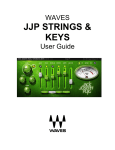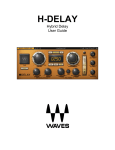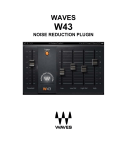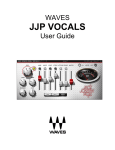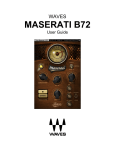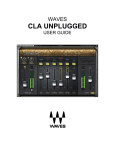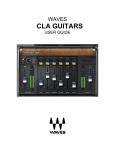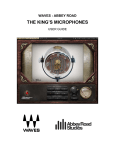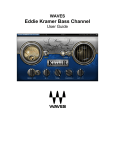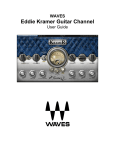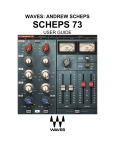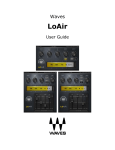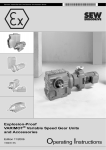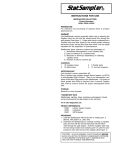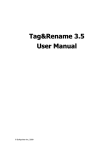Download Center User Manual
Transcript
Waves Center User Guide TABLE OF CONTENTS Chapter 1 – Introduction.................................................................................................... 3 1.1 Welcome.................................................................................................................. 3 1.2 Product Overview .................................................................................................... 3 1.3 Concepts and Terminology...................................................................................... 4 Chapter 2 – Quickstart Guide............................................................................................ 5 Chapter 3 – Interface and Controls ................................................................................... 6 3.1 Interface................................................................................................................... 6 3.2 Controls ...................................................................................................................7 Chapter 4 – The WaveSystem ........................................................................................ 11 4.1 The WaveSystem Toolbar ..................................................................................... 11 Toolbar Functions .................................................................................................... 11 4.2 Preset Handling ..................................................................................................... 11 Preset Types............................................................................................................ 11 Loading Presets and Setups.................................................................................... 12 Saving Presets and Setups...................................................................................... 12 Deleting Presets....................................................................................................... 13 A/B Comparison and Copying.................................................................................. 13 4.3 Interface Controls .................................................................................................. 13 Toggle Buttons......................................................................................................... 13 Value Window Buttons............................................................................................. 14 Sliders ...................................................................................................................... 14 Hover Box ................................................................................................................ 14 Multiple Selection of Controls .................................................................................. 14 TAB Functions ......................................................................................................... 15 Waves Center User Guide 2 Chapter 1 – Introduction 1.1 Welcome Thank you for choosing Waves! In order to get the most out of your Waves processor, please take the time to read through this manual. In conjunction, we also suggest that you become familiar with www.wavesupport.net. There you will find an extensive Answer Base, the latest Tech Specs, detailed Installation guides, new Software Updates, and current information on Authorization and Registration. By signing up at www.wavesupport.net, you will receive personalized information on your registered products, reminders when updates are available, and information on your authorization status. 1.2 Product Overview Ideal for final mixes and mastering, Waves Center is an innovative new processor that separates phantom Center content from Side (L/R) content. With Center, you can zero in on the phantom center and bring out or bring down the vocals without affecting everything else. Perfect for post-production engineers and DJs as well, Center lets you reposition, isolate, and even eliminate elements of your mix. Using a unique dynamic engine which considers the amplitude, frequency, and time envelope of stereo sources, Center gives you the power to radically re-balance your spatial imagery. Adjustable punch, high frequency, and low frequency controls let you focus on Center or Side elements. Waves Center is ideal for a wide range of audio applications: Post-Production Enhance dialog or narration Control the ambience/reverb of stereo location recordings Improve mono compatibility Mixing and Mastering Bring out the lead vocals in a finished mix Re-image stereo drum overheads Balance stereo recordings of individual or groups of acoustic instruments Widen or narrow the stereo spread DJ Remove vocals for karaoke Remove instrumental tracks for remixes and mash-ups Manipulate samples and drum loops Waves Center User Guide 3 1.3 Concepts and Terminology Waves Center Technology Waves Center employs a unique dynamic engine which considers the amplitude, frequency, and time envelope of stereo sources, providing a program-based Center and Sides (Left/Right) signal split. Waves Center uses a detector that looks for those elements of the stereo signal whose left and right time and frequency properties are equal. These elements comprise what is known as the ‘Phantom Center.’ The detected signal is extracted from the original stereo input and routed to a discrete internal bus. This “Center” signal is then remixed back with the “Sides”, using the fader controls. Center (or ‘phantom center’) is a mono signal containing equal Left / Right time and frequency properties. Sides is a stereo signal containing all Left / Right content whose time and frequency properties are NOT equal.. Waves Center offers Low, High and Punch controls for fine-tuning the frequency- and time-detection process. Phantom Center Since the early days of stereo, the ‘phantom center’ phenomenon has been used to define the center spatial image reproduced by a pair of speakers or headphones. Certain elements, including vocals, dialog, bass guitar, bass drum, snare, and solo instruments, can usually be heard in the phantom center. Waves Center enables you to re-mix the phantom Center elements with the Sides content. Waves Center User Guide 4 Chapter 2 – Quickstart Guide • • • • • • • Load Waves Center on a stereo track. Use the Center and Sides faders to adjust their balance. For example, to trim down lead vocals, slide the Center fader downwards. The Center meter indicates when center content is detected. Use the High control to balance high frequency content between the Center and Sides. For example, you can move the high frequency content of overhead drum mics by repositioning it to the sides. Use the Low control to balance low frequency content between the Center and Sides. For example, after lowering vocal levels by moving the Center fader downwards, lost low frequency content can be restored by turning the Low control toward the Sides. Use the Punch control to adjust the spread of transient content between the Center and Sides. For example, after lowering vocal levels by moving the Center fader downwards, lost transient information can be restored by turning the Punch control toward the Sides. Adjust the overall gain by using the Master gain control. Waves Center User Guide 5 Chapter 3 – Interface and Controls 3.1 Interface Waves Center User Guide 6 3.2 Controls Low controls balance of low frequency content between the Center and Sides. Range 0 - 100 (0=Center) High controls balance of high frequency content between the Center and Sides. Range 0 - 100 (0=Center) Punch controls the spread of transient content between the Center and Sides, affecting the center detection and the center detection meter. Range 0 - 100 (0=Center) Waves Center User Guide 7 Master Gain controls the overall stereo gain. Range +6dB to -24dB Center controls the Center gain. Range +6dB to Off Waves Center User Guide 8 Sides controls the Sides gain. Range +6dB to Off Output Meters display the stereo output after processing. Range 0 dBFS to -36 dBFS Waves Center User Guide 9 Center Detection Meter Displays the detected Center content of the stereo source, post-Punch control, preCenter gain, High, and Low settings. (Center detection is affected by the Punch control setting.) A mono input will display a full Center meter, while different program material in Left and Right channels will display an empty Center meter. Waves Center User Guide 10 Chapter 4 – The WaveSystem 4.1 The WaveSystem Toolbar All Waves processors feature the WaveSystem toolbar which takes care of most administrative functions you will encounter while working with your Waves software. The features of the WaveSystem toolbar are the same on practically all Waves processors, so familiarity with its features will be helpful whichever processor you are using. Toolbar Functions Undo Redo Setup A/B Copy A->B Load Save ? Undoes the last 32 performed actions. Waves Center supports multiple undo levels. Redoes the last 32 undone actions. Toggles between two presets. This is useful for close comparison of different parameter settings. Copies the current settings to the second preset register. Recalls presets from file. Saves presets in the Waves file formats. Opens the manual for the processor you are using. 4.2 Preset Handling Preset Types Factory Presets are permanent presets in the Load menu. Factory presets cannot be over-written or deleted. When applicable, different component plug-ins may have different factory presets. User Presets are your favorite settings of the plug-in saved as a preset in the Load menu, under ‘User Presets’. User Presets can be over-written and deleted. Setup Files may contain more than one preset. For example, a single file can contain all the presets for a session. When you open a Setup File, all its setups become part of your Load pop-up menu for fast access. This can be particularly useful with multiple instances of a plug-in in a single session. By saving all the settings you create into a single Setup File, they can all be quickly available for every instance of that plug-in. Waves Center User Guide 11 Loading Presets and Setups Click-and-hold on the Load button to see the Load pop-up menu. The menu is divided into four sections. If a section is not currently available it will not appear in the Load popup menu. Open Preset File… Select to open any setup or preset file, whether from the Library or your own creations. ‘Filename.xps’: Displays any currently loaded Setup File and its presets. Displays the default Factory Presets. Factory Presets: User Presets: Displays any loaded User Presets. Saving Presets and Setups Click-and-hold on the Save button to see the Save pop-up menu. Four options are available. If an option is not currently available it will be grayed out and inaccessible. Save to New File… Select this to start a new Setup file. There are two prompts - first for the setup filename, then for the preset name. You must provide a name for both the setup file and the preset. Click OK (ENTER) to complete the save. It is a good idea to create a folder in which to save several setup files for a project. Save ‘File Name’ – “Preset Name” Overwrites the settings of the loaded preset (whether a User Preset or a preset from a Setup File) with the current settings. If a Setup File is currently loaded, the name of the Setup File is displayed followed by the name of the preset itself. If a User Preset is loaded, its name is displayed. Save to ‘File Name’ As… Saves the current settings as a new preset into the Setup file that is open (if one is not open, the option is grayed out). You will be prompted to give the preset a name. Put into Preset Menu As… Save the current settings into a User Preset that will always be in your Load menu (until deleted). You will be prompted to give this preset a name. User Presets are stored in the plug-in’s preference file. Waves Center User Guide 12 Deleting Presets You may delete User Presets and presets within a Setup File. Factory Presets and Setup Library files cannot be deleted or overwritten. 1. Hold the Command (Mac)/Control (PC) key down. 2. Click-and-hold the Load button to see the pop-up menu. 3. While still holding the Command/Control key, select the preset or setup to delete. 4. A confirmation box will appear, allowing you to cancel or ‘OK’ the deletion. A/B Comparison and Copying The Setup A/Setup B button may be clicked to compare two settings. If you load a preset in the Setup B position, this will not affect the preset loaded into the Setup A position, and vice-versa. If you want to slightly modify the settings in Setup A, you can copy them to Setup B by clicking on the Copy to B button, then alter Setup A and compare with the original Setup B. The name of the current setup will be shown in the title bar (on platforms which support it), and will switch as you change from Setup A to Setup B. Note: an asterisk will be added to the preset name when a change is made to the preset - 4.3 Interface Controls Controls can be in one of three states: • • • Not Selected where the control is not the target of any user entry Selected where the control is the target of mouse control entry only Selected and Active where the control is the target for both mouse and keyboard entry Toggle Buttons Toggle buttons display the state of a control, and allow switching between two or more states. Single-click to change the control’s state. Some toggle buttons have a text display which updates with the current setting, and others (bypass, solo, or monitoring toggles) illuminate when the control is active. Waves Center User Guide 13 Some processors have link buttons between a pair of toggle buttons, allowing clickand-drag adjustment while retaining the offset between the controls. Value Window Buttons Value windows display the value of a control and allow click-and-drag adjustment, or direct control via the keyboard. • • • Using the mouse, click-and-drag on the value window to adjust. Some value windows support left/right, some up/down (as you hover over a button, arrows will appear to let you know which direction of movement that button supports). Using the arrow keys, click once with mouse to select the button, and then use up/down – left/right (depending on the direction supported by that button) to move in the smallest incremental steps across the button’s range (holding down the arrow keys will move faster through the range). Using key entry, double click on the button to open the value window, and directly enter the value from your keyboard. If you enter an out of range number, the button stays selected but remains at the current setting (system beeps? If system sounds are on?) Some processors have link buttons between a pair of value windows, allowing clickand-drag adjustment while retaining the offset between the controls. Sliders Click on the slider itself or anywhere within the sliders track. The numerical value of the slider settings is displayed in a hover window above the slider path. Hover Box Hovering boxes will appear and display the control value when hovering with the mouse over the control. Multiple Selection of Controls One of the most powerful features of the WaveSystem is the ability to select and adjust many controls at the same time. Using the mouse, simply drag-select the desired group of button or graphic controls by clicking and holding at a point outside the controls and forming a rectangle to include the controls you wish to adjust. Alternatively, you can hold down Shift while clicking the mouse on any control you wish to link. This second method is useful when you want to select two (or more) controls that are separated on the GUI by other controls you do not wish to select. Waves Center User Guide 14 TAB Functions TAB moves the ‘selected’ status to the next control, with shift-TAB moving in the reverse direction. Additionally, the Mac has an option-TAB function for ‘down’ movement and shift-optionTAB for ‘up’ movement where applicable. If you have several Value Window Buttons selected, TAB functions will take you through the selected controls only. Waves Center User Guide 15















